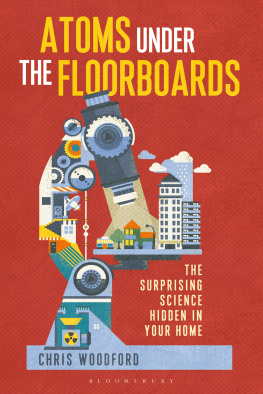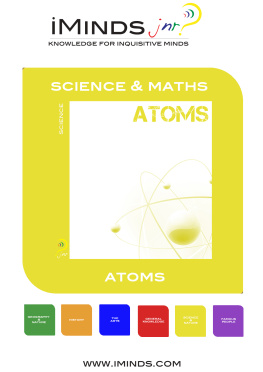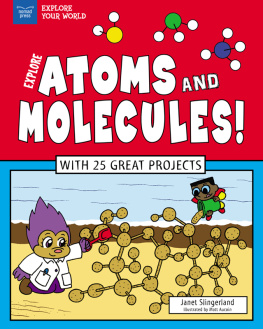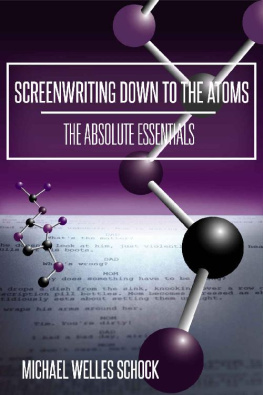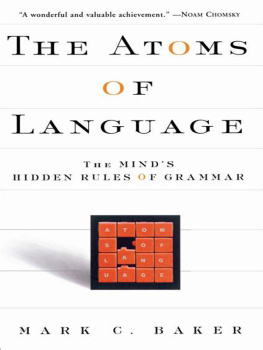
Also available in the Bloomsbury Sigma series:
Sex on Earth by Jules Howard
p 53 The Gene that Cracked the Cancer Code by Sue Armstrong

Bloomsbury Sigma
An imprint of Bloomsbury Publishing Plc
| 50 Bedford Square | 1385 Broadway |
| London | New York |
| WC1B 3DP | NY 10018 |
| UK | USA |
www.bloomsbury.com
BLOOMSBURY and the Diana logo are trademarks of Bloomsbury Publishing Plc
First published 2015
Copyright Chris Woodford, 2015
Chris Woodford has asserted his right under the Copyright, Designs and Patents Act, 1988 , to be identified as Author of this work.
All rights reserved. No part of this publication may be reproduced or transmitted in any form or by any means, electronic or mechanical, including photocopying, recording, or any information storage or retrieval system, without prior permission in writing from the publishers.
No responsibility for loss caused to any individual or organisation acting on or refraining from action as a result of the material in this publication can be accepted by Bloomsbury or the author.
British Library Cataloguing-in-Publication Data
A catalogue record for this book is available from the British Library.
Library of Congress Cataloguing-in-Publication data has been applied for.
ISBN (hardback) 978-1-4729-1222-0
ISBN (trade paperback) 978-1-4729-1822-2
ISBN (paperback) 978-1-4729-1223-7
ISBN (ebook) 978-1-4729-1224-4
2 4 6 8 10 9 7 5 3 1
Typeset in 12pt Bembo Std by Deanta Global Publishing Services, Chennai, India
Contents
How much would you say you have in common with science superstar Albert Einstein, the German-born genius who spawned Flash Gordon ideas like nuclear bombs and solar power? Load the question like that, and Not so much is probably your first thought. And yet you might be surprised. To start with you share . per cent of Einsteins DNA (you share per cent with a chimpanzee and per cent with a banana, but well set these inconvenient truths aside for now). Did you hate school? Einstein did too: although a superb student, he dropped out of high school and picked up his education a year later at a technical college. Ever flunked an important exam? You and Einstein both: despite demonstrating brilliance in maths and physics, he botched his entrance exams to Zurich Polytechnic and had to put his studies on hold once more. Ever struggled to get the job you wanted? Einstein would have sympathised: after graduating he fired off endless, useless applications for every academic post he could think of, even considering a tiresome job in insurance to support his family, before finally winding up as a humdrum patent clerk. The most extraordinary scientist of the th century was, in many respects, a most ordinary sort of failure.
We love and revere Einstein not because he was brilliant beyond measure, but because he was a reassuringly flawed, human sort of genius, smart enough to know everything and wise enough to know nothing . With squeaky, cheeky scribbles on the blackboard, he reinvented matter, energy, light and gravity the most fundamental scientific concepts in a baffling new theory called relativity that could stretch space and time like elastic. Yet, at the same time, he understood that science is, fundamentally, just another way of looking at things, and that scientific ideas, divorced from the sparkle and drudgery of everyday life, mean little or nothing to most. Gravitation, he once wisely said, is not responsible for people falling in love.
Science was Einsteins life, but its probably not yours. You can pass three score years and ten without thinking about science for a moment but you cant survive even a nanosecond without using science in one way or another. From Wi-Fi Internet to heat-reflecting windows, from brain scans to test-tube babies, science fires the technology that makes modern lives worth living, but still baffles most of us, even when weve spent years studying it in school. Recent opinion surveys show that per cent of us are interested or very interested in science, and happily acknowledge how important it is. Yet per cent think its too specialised or too hard to understand, and two-thirds of -year-olds find it uninspiring. We confuse the ozone layer and climate change, we think nuclear power is more risky than crossing the road, and despite per cent of us thinking that newspapers and TV sensationalise science, per cent of us rely on precisely these unreliable media to keep us informed.
This book is designed to help put things right by exploring the science of everyday life in an engaging and entertaining way. Wandering around your home, it picks out the fascinating and surprising scientific explanations behind all kinds of everyday things, from gurgling drains and squeaky floorboards to rubbery custard and shiny shoes.
A note about notes; this book is meant to be an easy read for non-scientists, so Ive kept detailed explanations, quibbles and qualifications to a minimum and avoided maths wherever possible. Youll find small superscript numbers dotted through the text pointing to a short section of notes and references at the end of the book.
Why is falling off a ladder as dangerous as being bitten by a crocodile? Is it better to build skyscrapers like wobbly jellies or like stacks of chocolate biscuits? How many atoms would you have to split to power a light bulb? Is there a scientifically correct way to stir your tea? Theres nothing complex or baffling about the answers; its not rocket science (even when it is). Theres very little maths in this book to baffle or bore you; you really dont have to be Einstein to understand these things clearly and completely.
Im no Einstein, but Ive read some of his original papers and scratched my head over his elegant equations. To my mind, the deepest and truest thing he ever said was a simple sentence anyone can understand: The whole of science is nothing more than a refinement of everyday thinking. Thats the everyday thought behind this book: its science, if you will, for the rest of us.
In this chapter, we discover
How much a house weighs and why it doesnt sink into the ground.
Why your ankles work almost as hard as a buildings foundations.
How tall buildings stay upright and what makes them fall down.
Why soaring skyscrapers need to wobble like jellies.
S cribbling novels, daubing portraits, rattling a piano through a Beethoven sonata there are many things that are uniquely human. However, building things isnt one of them. Theres no disputing that architects are among the most visionary of creatives, but the essence of what they do dreaming up shelters that gravity cant tear down is something many other animals do too. From snow domes built by grizzly bears to beaver dams that block the rush of the river, building for shelter is a trait shared by almost every species on land.
What makes humans different is the daring variety of the things we build. We have skyscrapers a quarter of a mile high and warehouses big enough to birth space rockets. Weve got stone pyramids that have stood, silent and majestic, for about , years. Weve all of us, at some point or another, built a house of cards that collapsed in seconds. Weve got office blocks where , people simultaneously poke at keyboards or tell jokes around the water cooler. And we have phone boxes small enough to share the biggest secrets. Yet, for all their creative cunning, their desperate longing for originality, the boxes we plot and plan and raise so carefully from the ground are fundamentally no different from the homes animals scrape together from twigs and mud. Thats because all buildings are shelters and all shelters, human or animal, have one thing in common: they use solid science to beat forces like gravity, wind, earthquakes and decay.
Next page
